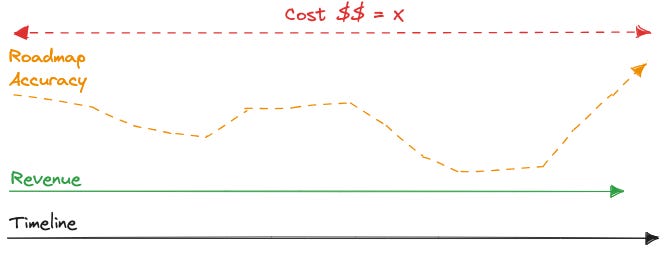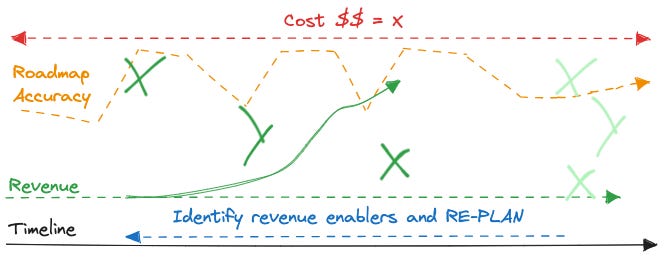This issue of Crafting Tech Teams is about the two most common team identities: Outcome + Profit increase vs. Activity + Cost reduction. You’ll be able to explore why Tactical Agility—feature slicing across fully functional verticals in combination with frequent, autonomous replanning increases the profit targets of high performing teams.
An unmarked map tells you about cost
Map out your roadmap. Business Strategy. Product Roadmap. Then the Engineering One. Are the value streams clear? Have you found your required budget for cash flow and an expected ROI?
Good. Those are the basics. Now communicate all three levels: Business, Product and Engineering to the Engineering team. The why. The how. Which features are important? Which ones complex and will take a long time? What questions will you ask of your clients and users?
If this is unusual or uncomfortable, I recommend you start with the article below:
High Performing Teams: Where do the Risks come from?
In this issue we’re exploring risk areas that can slow down your team’s development process. This is a combination of expectation management, building trust with business stakeholders and lack of experience. Product and Engineer team relations are a mixed bag of unresolved tension, imposter syndrome and lack of trust. You need to be a good poker player a…
Revenue generating features provide opportunity
Standard operations in many faux-Agile organisations. You build a project roadmap. You set a budget. You plan the resources. Measure velocity so that your PO’s have something to manage.
If elements from the previous chapter are missing, it’s very likely that the team is planning to exhaust the entire budget and entire timeline to produce the best version of the software. In that scenario, the revenue-generating features inevitably end up just at the end of the project.
Despite best efforts, that’s what the deadline is trying to promote—when the important features are done. At the end of course. The initiative now has a projected cost and timeline.
This is an all-in strategy. Notice how there is no ROI or revenue increase as the project progresses while accruing more and more costs. Further, the longer the project takes the lower the roadmap accuracy drops. This means further unexpected delays and cost increases with no extra revenue benefits.
Acting on the opportunity provides improvement
A high performing team will devote all of their attention to:
prioritising end-to-end, crude releases of features
identifying which ones are revenue-generating
making sure wasteful features are removed in favour of revenue-generating ones
establish communication channels with product & the business to notify of aggressive roadmap shifts
It is crucial that a team is focusing on the question “Do we know which features will provide the most value (captured revenue)?“. When answers to this question are vague or unknown, the team will deviate from the roadmap as soon as possible to create knowledge based on user feedback of prototype releases.
We are talking end-to-end version one, two, three with limited backend functionality and design polish. Event Modeling is paramount for planning this— especially when the built decisions are irreversible and parallel (also known as Set-Based Concurrent Engineering).
When a Team doesn’t know which Features drive revenue, they are doomed to fail continuously with no end in sight.
The team aims to update the roadmap when shifts in feature, and value-stream understanding helps them reorganise the release milestones. The outcome is that revenue-generating features—even though they were included in the roadmap originally—are moved to be completed sooner.
Check out more on high performing teams on my talk below:
Improvement allows greater profit
Now is when the team connects the dots with the original budgets and roadmaps. Having a clear understanding of their own cost to the business along with their cost to any clients they can create a clear understanding of their ROI.
While it may not immediately increase profits to the team, it certainly increased profits for the client. If the client was internal or another department, so much better!
However, the team has added additional, unexpected value to the customer or department who influenced the team’s business strategy:
They have created experience and knowledge
Released a product within constraints that started generating revenue sooner than expected
Provided an increase of certainty and transparent communication during the inception of the roadmap
So even though this team may not capture more revenue right now— they can certainly increase their prices and sales targets going forward with this track record.











